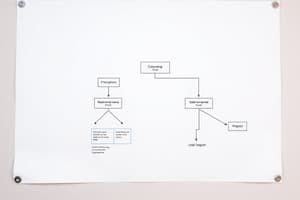Podcast
Questions and Answers
What does a Class represent?
What does a Class represent?
- A group of things that have common state and behavior (correct)
- A single object with unique properties
- A type of data structure
- None of the above
What is described by a class diagram?
What is described by a class diagram?
- The behavior of individual objects
- Types of entities in the system and the various kinds of structure that exist (correct)
- Algorithms for data processing
- None of the above
What is a Conceptual Object?
What is a Conceptual Object?
A discrete set of instances of a domain-specific concept that are manipulated by the system.
Which of the following are Types of Conceptual Objects?
Which of the following are Types of Conceptual Objects?
What characterizes an Entity?
What characterizes an Entity?
What is an Association?
What is an Association?
What is an Event?
What is an Event?
What defines an Agent?
What defines an Agent?
What does Association Relationship refer to?
What does Association Relationship refer to?
What does Aggregation represent?
What does Aggregation represent?
What does Composition signify?
What does Composition signify?
What is Generalization in class diagrams?
What is Generalization in class diagrams?
What is the first step in developing a Class Diagram?
What is the first step in developing a Class Diagram?
What is the second step in developing a Class Diagram?
What is the second step in developing a Class Diagram?
What is the third step in developing a Class Diagram?
What is the third step in developing a Class Diagram?
What is the fourth step in developing a Class Diagram?
What is the fourth step in developing a Class Diagram?
What is the fifth step in developing a Class Diagram?
What is the fifth step in developing a Class Diagram?
Flashcards are hidden until you start studying
Study Notes
Class and Class Diagrams
- Class: A group of objects sharing common state and behavior.
- Class Diagram: Visual representation outlining types of entities in a system and their structural relationships.
Conceptual Objects
- Conceptual Object: A distinct set of instances representing a domain-specific concept, managed by the system.
- Types of Conceptual Objects: Include Entity, Association, Event, and Agent.
Types of Conceptual Objects Explained
- Entity: Represents a passive and autonomous object within the system.
- Association: Symbolizes a connection or link between dependent objects.
- Event: An instantaneous object in the context of the system.
- Agent: An active and autonomous object that performs actions.
Relationships and Structures
- Association Relationship: Defined by multiplicity, indicating the potential count of participating objects in the association.
- Aggregation: Describes a whole-part relationship, indicating a collection of objects.
- Composition: Represents ownership, where the lifetime of contained objects is tied to the lifetime of the container object.
- Generalization: A concept that abstracts common features from multiple entities into a general class.
Steps to Develop Class Diagrams
- Step 1: Identify core classes that will be included in the model.
- Step 2: Construct class structures that define associations between these classes.
- Step 3: Define attributes associated with each class to detail their properties.
- Step 4: Specify messages that can be communicated between classes to outline interactions.
- Step 5: Refine the class model to enhance clarity and accuracy in representing the system.
Studying That Suits You
Use AI to generate personalized quizzes and flashcards to suit your learning preferences.




